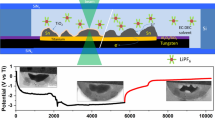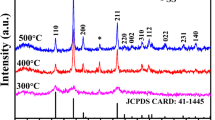Abstract
Fading mechanism of tin dioxide (SnO2) electrodes in lithium ion batteries has attracted much attentions, which is of great importance for the battery applications. In this paper, electrochemical lithiation-delithiation cycles of individual SnO2 nanowires were conducted in situ in a high-resolution transmission electron microscopy (TEM). Major changes in volume with expansions of 170%∼300% on SnO2 nanowire electrodes were observed during the first lithiation process in electrochemical cycling, including conversion reaction of SnO2 precursor to Li2O matrix and active lithium host Sn, and alloying of Sn with Li to form brittle Li-Sn alloy. SnO2 nanowire electrodes were inclined to suffer from thermal runaway condition in the first two cycles. During cycling, morphology and composition evolution of SnO2 nanowire electrodes were recorded. Cyclic lithiation and delithiation of the electrode demonstrated the phase transition between Li13Sn5 and Sn. Metallic Sn clusters were formed and their sizes enlarged with increasing cycle times. Detrimental aggregation of Sn clusters caused pulverization in SnO2 nanowire electrodes, which broke the conduction and transport path for electrons and lithium ions. The real-time in situ TEM revealed fading mechanism provides important guidelines for the viable design of the SnO2 nanowire electrodes in lithium ion batteries.
Similar content being viewed by others
References
Tarascon J M, Armand M. Issues and challenges facing rechargeable lithium batteries. Nature, 2001, 414: 359–367
Chan C K, Peng H L, Liu G, et al. High performance lithium bat tery anodes using silicon nanowires. Nat Nanotechnol, 2008, 3: 31–35
Zhao K J, Pharr M, Vlassak J J, et al. Fracture of elcetrodes in lithiumion batteries caused by fast charging. J Appl Phys, 2010, 108: 073517
Wang H F, Jang Y, Huang B Y, et al. TEM study of electrochemical cycling-induced damage and disorder in LiCoO2 cathodes for rechargeable lithium batteries. J Electrochem Soc, 1999, 146: 473–480
Bhattacharya S, Riahi A R, Alpas A T. In-situ observations of lithiation/de-lithiation induced graphite damage during electrochemical cycling. Scripta Mater, 2011, 64: 165–168
Arara P, White R E, Doyle M. Capacity fade mechanisms and side reactions in lithium ion batteries. J Electroche Soc, 1998, 145: 3647–3667
Idota Y, Mishima M, Miyaki Y, et al. European Pat, 1995, 651: 450A1
Idota Y, Kubota T, Matsufuji A, et al. Tin-based amorphous oxide: A high-capacity lithium-ion-storage material. Science, 1997, 276: 1395–1397
Brousse T, Retouxf R, Herterich U, et al. Thin-film crystalline SnO2-lithium electrodes. J Electrochem Soc, 1998, 145: 1–4
Wang Y, Zeng H C, Lee J Y. Highly reversible lithium storage in porous SnO2 nanotubes with coaxially grown carbon nanotube overlayers. Adv Mater, 2006, 18: 645–649
Courtney I A, Dahn J R. Electrochemical and in situ X-ray diffraction studies of the reaction of lithium with tin oxide composites. J Electrochem Soc, 1997, 144: 2045–2052
Courtney I A, Dahn J R. Key factors controlling the reversibility of the reaction of lithium with SnO2 and Sn2BPO6 glass. J Electrochem Soc, 1997, 144: 2943–2948
Courtney I A, McKinnon W R, Dahna J R. On the aggregation of tin in SnO composite glasses caused by the reversible reaction with lithium. J Electrochem Soc, 1999, 146: 59–68
Winter M, Besenhard J O, Albering J H, et al. Lithium storage alloys as anode materials for lithium ion batteries. Progress in Batteries and Battery Materials, 1998, 17: 208–213
Wang C M, Xu W, Liu J, et al. In situ transmission electron microscopy observation of microstructure and phase evolution in a SnO2 nanowire during lithium intercalation. Nano Lett, 2011, 11: 1874–1880
Zhang L Q, Xiao X H, Perng Y C, et al. Direct observation of Sn crystal growth during the lithiation and delithiation processes of SnO2 nanowires. Micron, 2012, 43: 1127–1133
Gao P, Kang Z C, Fu W Y, et al. Electrically driven redox process in cerium oxides. J Am Chem Soc, 2010, 132: 4197–4201
Wang L F, Tian X Z, Yang S Z, et al. Dynamic nanomechanics of zinc oxide nanowires. Appl Phys Lett, 2012, 100: 163110
Yang S Z, Wang L F, Tian X Z, et al. Piezotronic effect of zinc oxide nanowires studied by in situ TEM. Adv Mater, 2012, 24: 4676–4682
Liu Y, Hudak N S, Huber D L, et al. In situ transmission electron microscopy observation of pulverization of aluminum nanowires and evolution of the thin surface Al2O3 layers during lithiation delithiation cycles. Nano Lett, 2011, 11: 4188–4194
Brousse T, Defives D, Pasquereau L, et al. Metal oxide anodes for Li-ion batteries. Ionics, 1997, 3: 332–337
Hong J S, Maleki H, Hallaj S A, et al. Electrochemical-calorimetric studies of lithium-ion cells. J Electrochem Soc, 1998, 145: 1489–1501
Jarzebski Z M, Marton J P. Physical properties of SnO2 materials: III. Optical properties. J Electrochem Soc, 1976, 123: 333C–346C
Winter M, Besenhard J R O. Electrochemical lithiation of tin and tin-based intermetallics and composites. Electrochem Acta, 1999, 45: 31–50
Woodford W H, Chiang Y M, Carterz W C. “Electrochemical shock” of intercalation electrodes: A fracture mechanics analysis. J Electrochem Soc, 2010, 157: A1052–A1059
Viswanathan V V, Choi D, Wang D, et al. Effect of entropy change of lithium intercalation in cathodes and anodes on Li-ion battery thermal management. J Power Sources, 2010, 195: 3720–3729
Li H, Huang X J, Chen L Q. Electrochemical impedance spectroscopy study of SnO2 and nano-SnO2 anodes in lithium rechargeable batteries. J Power Sources, 1999, 81: 340–345
Kim C, Noh M, Choi M, et al. Critical size of a nano SnO2 electorde for Li-secondary battery. Chem Mater, 2005, 17: 3297–3301
Aricò A S, Bruce P, Scrosati B, et al. Nanostructured materials for advanced energy conversion and storage devices. Nat Mater, 2005, 4: 366–377
Poizot P, Laruelle S, Grugeon S, et al. Nano-sized transition-metal oxides as negative-electrode materials for lithium-ion batteries. Nature, 2000, 407: 496–499
Huang J Y, Zhong L, Wang C M, et al. In situ observation of the electrochemical lithiation of a single SnO2 nanowire electrode. Science, 2010, 330: 1515–1520
Liu X H, Huang J Y. In situ TEM electrochemistry of anode materials in lithium ion batteries. Energy Environ Sci, 2011, 4: 3844–3860
Liu X H, Wang J W, Huang S, et al. In situ atomic-scale imaging of electrochemical lithiation in silicon. Nat Nanotechnol, 2012, 7: 749–756
Author information
Authors and Affiliations
Corresponding author
Electronic supplementary material
Supplementary material, approximately 3.45 MB.
Supplementary material, approximately 263 KB.
Supplementary material, approximately 3.42 MB.
Rights and permissions
About this article
Cite this article
Wang, L., Xu, Z., Yang, S. et al. Real-time in situ TEM studying the fading mechanism of tin dioxide nanowire electrodes in lithium ion batteries. Sci. China Technol. Sci. 56, 2630–2635 (2013). https://doi.org/10.1007/s11431-013-5328-9
Received:
Accepted:
Published:
Issue Date:
DOI: https://doi.org/10.1007/s11431-013-5328-9




